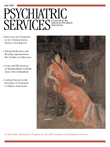June 2007: This Month's Highlights
Law and Mental Health
Four articles in this issue focus on persons with serious mental illness who become involved with the criminal justice system. In the lead article J. Steven Lamberti, M.D., presents a conceptual framework for understanding and preventing criminal recidivism in this population. The framework highlights risk variables related to the individual and the service system variables and emphasizes nonadherence as a mediator between modifiable risk variables and recidivism ( Original article: page 773 ). Another framework, this one for improving outcomes of encounters between police and people with mental illness, is described by Amy C. Watson, Ph.D., and Beth Angell, PhD., M.S.S.W. The framework is based on procedural justice theory, which emphasizes fair treatment and the opportunity to be heard ( Original article: page 787 ). In another article, H. Richard Lamb, M.D., and his colleagues present the results of an examination of the backgrounds of 104 male inmates in an urban county jail. Of the 78 who had a severe mental illness, virtually all had a history of nonadherence and prior arrests, and three-quarters required inpatient care or its equivalent during their current jail stay ( Original article: page 782 ). In the fourth article, Joseph P. Morrissey, Ph.D., and coauthors examined criminal recidivism for a year after jail release among more than 7,600 persons with severe mental illness. Having Medicaid benefits at release was associated with a reduction in subsequent detentions ( Original article: page 794 ). In a related Taking Issue commentary, Marvin S. Swartz, M.D., discusses mandated outpatient treatment and its role in preventing violence, such as the April shootings at Virginia Tech ( Original article: page 737 ).
Improving Treatment Adherence
Two articles and three brief reports focus on treatment nonadherence. Matthew J. Byerly, M.D., and associates compared nonadherence detected by electronic monitoring, which records when a bottle of medication is opened, with nonadherence ratings by 62 patients with schizophrenia or schizoaffective disorder and their prescribers. Electronic monitoring may overestimate adherence but is unlikely to underestimate it. Both prescribers and patients grossly underestimated nonadherence rates (7% and 5%, respectively) compared with electronic monitoring (57%) ( Original article: page 844 ). In the second article Martha Sajatovic, M.D., and colleagues used pharmacy data and medication possession ratios (MPRs) to examine adherence among 44,637 veterans with bipolar disorder. They found that 54% were fully adherent, 25% were partially adherent, and 21% were nonadherent ( Original article: page 855 ). A brief report by Emily M. Woltmann, M.S.W., and coauthors assessed whether use of MPRs is an accurate method for identifying nonadherent patients. In examining charts of 1,712 veterans with MPRs that indicated partial adherence, they found alternative explanations for the low refill rates for 17% ( Original article: page 864 ). Missed psychiatric appointments are the focus of two other brief reports. A U.K. study found wide variance by specialty ( Original article: page 868 ), and a pilot study in Appalachia found that phone reminders were effective when therapists themselves made the calls ( Original article: page 872 ).
Costs and Effectiveness of Telepsychiatry
Use of videoconferencing methods to provide treatment to underserved populations and address disparities holds great promise, especially as technologies improve. Two studies in this month's issue address ongoing concerns about the costs and effectiveness of telepsychiatry. In the first study Jay H. Shore, M.D., M.P.H., and colleagues documented various costs of conducting structured psychiatric interviews with 54 American-Indian male veterans in rural locations in 2003 and 2005. Videoconferencing was used with one-half of the group, and in-person interviews were used with the other half. Changes introduced via new technologies in 2005 greatly reduced port fees and long-distance costs, yielding substantial savings for telepsychiatry ( Original article: page 830 ). A Canadian study used similar random assignment to a videoconference interview or a face-to-face interview of 495 adults who were referred for psychiatric consultation. Richard O'Reilly, M.B., F.R.C.P.C., and associates found equivalent clinical outcomes for consultation and short-term follow-up in both groups and similar levels of patient satisfaction ( Original article: page 836 ). An exchange in the letters section addresses potential cultural issues in the use of telepsychiatry for Hispanic patients ( Original article: page 877 ).
Briefly Noted …
• Two psychiatrists provide guidelines for culturally sensitive treatment of Filipino Americans ( Original article: page 810 ).
• Quality of care for bipolar disorder is the focus of two studies—one of a large Medicaid population ( Original article: page 848 ) and the other of a sample of 435 veterans ( Original article: page 740 ).
• The Best Practices column describes the purpose of drug class reviews, methods used to conduct them, and issues for clinicians, administrators, and policy makers ( Original article: page 746 ).



